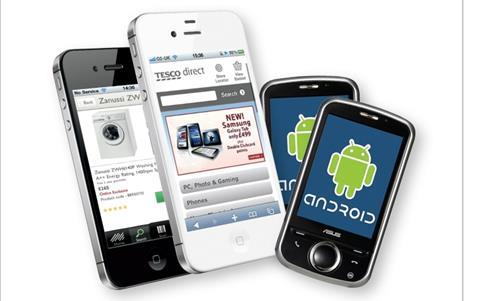Most retailers are now working hard on their mobile offers, and there are plenty of lessons to be learned. Jessica Twentyman highlights pitfalls to avoid in order to provide a high-quality customer experience.

Over the past decade, internet shopping has brought the high street into customers’ homes and offices. Now retailers face a new challenge: how to attract a new breed of shopper, one who’ll happily make purchases from a device they carry in their pockets.
More and more UK customers are comfortable using their mobile phones to shop online. Consumers will spend £4.5bn in 2012 – a 53% rise on 2011 mobile retail sales and a staggering six-fold increase from 2010, according to price comparison site Kelkoo and analysts at the Centre for Retail Research.
If those predictions are correct, retailers cannot afford to ignore the impact mobile has on retail. The same research suggests almost half (46%) of UK mobile users already own an iPhone, Android or Blackberry device – that’s 24.6 million smartphones in the UK alone.
Mobile-optimised websites are the first port of call for many retailers, ensuring that sites are easily navigable on a small screen and not too big for slower mobile phone networks to cope with.
Increasingly, however, retailers are thinking in terms of mobile applications – software that is downloaded to the handset from an online library. Once installed, these applications can take advantage of phones’ sophisticated built-in functions, such as GPS (global positioning system) capabilities or the ability to scan barcodes.
That’s given rise to a lively debate among retailers about the ‘right’ way to go – a website that’s optimised for viewers using a mobile device with a browser, or a downloadable app that’s specific to their particular device?
They may be missing the point. The most common mistake retailers make at present is not to address this potentially huge opportunity at all, says Trenton Moss, director of user experience consultancy Webcredible.
Every year, the company analyses how customers use the online shopping experience offered by leading UK retailers in its annual Multichannel Retail Customer Experience Report. In its 2011 survey, Webcredible decided to evaluate, for the first time, customers’ experiences across mobile websites and mobile apps, too.
The results were surprising: of the 15 retailers assessed, six didn’t offer customers an optimised website or a mobile app at the time of the survey.
Those brands are making a big mistake, Moss believes. “The expectation of consumers to be able to shop wherever and whenever most convenient to them is driving the requirement for retailers to ensure their interactions across all platforms are up to scratch, and that includes mobile,” he says.
Those that aren’t able to meet such expectations, he believes, are sure to miss out on sales at a time when retailers are under pressure not to neglect any potential revenue channel.
Mobile site or mobile app?
To address the mobile retail opportunity, retailers need to bear in mind that a customer doesn’t actually need the latest smartphone – an iPhone, an Android handset or a Blackberry, for example – to shop from their mobile handset. Any mobile will do.
“For that reason, we strongly encourage our clients to avoid a strategy that focuses on just one or two of the ‘top’ devices. Their first concern should be ensuring they support all the phones out there,” says Jason Taylor, head of innovation and platform strategy at Usablenet, which provides technology for multichannel retailing to UK retailers including Marks & Spencer, Next and Tesco.
What matters to the customer is that the website that they access has been optimised for mobile use, says Robert Castley, lead consultant for EMEA at Keynote Systems, a website performance measurement company. “On a small mobile screen, the user experience is all about clarity, usability and speed,” he says. The fewer objects on a home page – text boxes, links, photographs and so on – the less time it takes to load.
It’s not just a question of eliminating unnecessary elements. It’s also a question of slimming down what’s left. As Castley points out, plenty of the elements – mostly images – that render well on a desktop PC take a long time to load on a mobile device. “It’s not only the speed of download that can frustrate mobile users, but the way that it eats into their data plan if they’re connecting over their mobile network, rather than a Wi-Fi connection,” he explains.
Castley adds if mobile users experience difficulties with your site, regardless of the reasons, they will automatically associate them directly with a retailer’s brand. So it’s in the retailer’s best interests to make it easy.
But that’s only half the story. Users with a smartphone might want more than the bog-standard mobile browser experience – but since that requires them to download a mobile app onto their device they will be expecting extra functions, too.
Having first optimised its website for mobile browsers back in October 2010, a function-rich, device-specific app was the logical next step for John Lewis, according to Sean O’Connor, the department store’s head of online delivery and customer experience.
The company’s mobile site enabled it to analyse customer behaviour, particularly behaviour related to individual physical stores. O’Connor says up to a third of customers used that mobile website to research shop information and research products online before buying.
“This helped us to understand user intent when using mobile and then led us to consider how we might develop mobile further to enhance the in-store experience,” he says.
As a result, the new John Lewis iPhone app enables users to scan barcodes in-store to access product information, read and compare reviews and browse the full John Lewis catalogue. Meanwhile, out-of-stock products can be ordered for delivery or in-store collection, and GPS functions enable users to locate the nearest John Lewis store. In other words, the app complements, rather than replaces, physical aspects of the John Lewis business.
The retailer went for the iPhone first because it was the most popular device among its customers – applications for other platforms will follow, says O’Connor.
But whether retailers have chosen an app or an optimised site, some mistakes are common to both approaches, says Moss.
Providing customers who are out shopping with the means to find the nearest store is one of the most important features of any mobile experience, he says, and a store locator should be one of the most prominent features of a mobile app or website.
Meanwhile, product pages need to be tailored appropriately. Customers should be able to filter and sort options to help narrow down lists of products quickly. They should be able to see good quality images, preferably with zoom. And they should have clear prompts to add products to their basket and clear feedback that indicates what stage they’ve reached in the buying process.
Finally, the checkout process needs to be optimised for mobile too. It should be assumed that most customers buying on mobile have already registered an account to make the checkout as simple as possible, minimising the number of key presses required and the mobile checkout should have access to all the account details previously entered online.
Getting mobile, online and in-store processes working together to create cohesive multichannel strategies will be a tough challenge for many. But the bigger issue will be providing a consistently high-quality experience across them all, allowing customers to easily purchase what they want, when they want and by whatever method they want.


























No comments yet